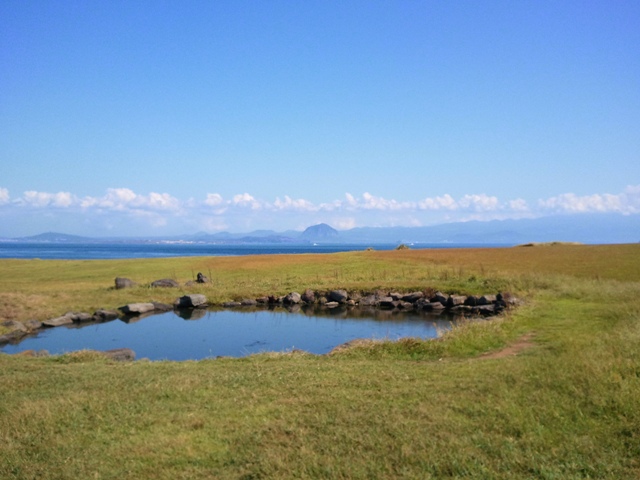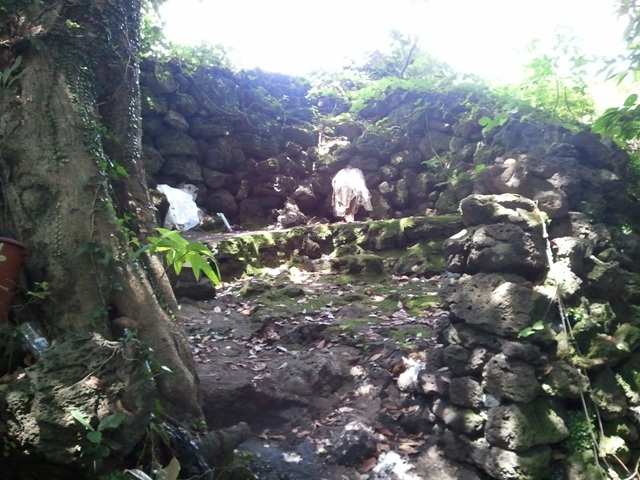
- Updated 2024.4.16 17:33
- All Articles
-
member
icon
-
facebook
cursor
-
twitter
cursor
| |
 |
|
| Jeju as seen from Mara-do. Photo by Anne Hilty. |
One of the most difficult subjects in mythology and world religion is that of virgin sacrifice.
Even as metaphor, the idea of a “pure” human sacrificed to the gods in order to ensure the community's well-being, also the central story of Christianity, is an uncomfortable yet universal theme.
Jeju too has such stories. And while there is no physical evidence to support their veracity, and they may be only allegory, they can be difficult to tell, or to hear.
Such are the tales of the Marado and Gwancheong Halmang.
The word “Halmang” is Jeju dialect for old woman or grandmother. It is also the term for “goddess” or any supreme or all-powerful female entity. Thus, even though these stories are about female children who were deified after death, they are not ultimately perceived as children but as strong, fully developed goddesses.
And, while youthful deaths are generally thought to result in a restless, unfulfilled spirit or “hungry ghost” needing consolation in the form of ritual or even a postmortem “spiritual marriage” – or even, in the case of sacrifice, vengeance – these two are remarkable in that they achieved peace in the spirit world and became beneficent deities for their villages.
Marado is a remote, barren island south of Jeju that was uninhabited until the late 19th century, its original name of “Keumdo” meaning “forbidden.”
The story of Marado Halmang begins when, as a young orphan girl in the southwest region of Jeju, she came to live with another family and care for their child. The husband a fisher and wife a diver [haenyeo], they traveled one day by boat to Mara, when a fierce wind arose and prevented their return home.
Ultimately, the wind god demanded that the girl, 10 years old, be left behind on the island as a sacrifice, and the fisher and diver reluctantly complied, by which they were afforded safe passage.
Three years passed before the haenyeo returned to the forsaken island, where she found and buried the girl's skeleton, preparing memorial rites and an altar now known as “agi-halmang-dang” or “child-goddess shrine.” The girl's spirit, not vengeful but understanding and kind, became the island's patron deity and, in light of the strong haenyeo culture that developed there, was thought to protect them.
The story of the Gwancheong maiden takes place not on an outlying island but in the eastern village of Susan, in Seongsan district. There, on a site where, ironically, an elementary school exists today, an old fortress wall can be found which once housed a government building [gwancheong] – and in one portion of it, a shamanist shrine still in use.
| |
 |
|
| Gwancheong shrine. Photo by Anne Hilty |
There were many problems when this fortress, yet another meant to keep out invaders from the east, was being constructed. Collapsing walls and other difficulties convinced the captain in charge that the gods were unhappy and needed to be appeased by means of virgin sacrifice.
All villagers had been commissioned for the building of the fortress, with the exception of those who were unable due to age or illness. One impoverished woman, unable to participate due to the care of her many children, was convinced through a misunderstanding to give up her 6-year old daughter to be sacrificed.
The daughter was entombed in the fortress wall, and the construction completed without further mishap. However, the villagers could hear sorrowful wailing from the region of the girl's tomb, and eventually constructed a shrine there to console her spirit, thereby deifying her. Thus satisfied, she became a benevolent goddess.
It is said that government officials and those seeking such appointment, in particular as they study for the civil servant examination, would go to this shrine to pray to Gwancheong Halmang.
Other virgin sacrifices have been noted in Jeju's mythology, including the “terrible snake god” of Gimnyeong who demanded same and was eventually killed by a magistrate from Seoul who had been assigned to govern this island. This may represent a turning point in local people's conception of virgin sacrifice.
The Tosan maidens, the death of whom was caused by the resident snake goddess herself as a demand for the villagers' worship, could be thought of as such. Other maiden goddesses, not sacrificed by villagers but whose lives were cut short by circumstance, are also found in the myths of Jeju.
Such sacrifice, however, is not a common theme, and the Marado and Gwancheong Halmang are thus remarkable.
If a lesson can be gleaned from these devastating stories, whether historic or allegorical, it is perhaps that the sacrifice of one for the sake of the whole can ultimately be redeemed through understanding and forgiveness.
–
Kim Soonie, Jeju native, is a mythologist and Jeju representative of the nation's Cultural Heritage Administration. Anne Hilty is a cultural health psychologist from New York who now makes Jeju Island her home. Interpretation / translation was provided by Han Youngsook, Jeju native and instructor at Jeju National University. |
|
|
|
|
|
|
|
ⓒ Jeju Weekly 2009 (http://www.jejuweekly.net)
All materials on this site are protected under the Korean Copyright Law and may not be reproduced, distributed, transmitted, displayed, published without the prior consent of Jeju Weekly. |
|
|
|
|
| Jeju-Asia's No.1 for Cruise |
|
|
|
Title:The jeju Weekly(제주위클리) | Mail to editor@jejuweekly.net | Phone: +82-64-724-7776 Fax: +82-64-724-7796
#503, 36-1, Seogwang-ro, Jeju-si, Jeju-do, Korea, 63148
Registration Number: Jeju, Ah01158(제주,아01158) | Date of Registration: November 10,2022 | Publisher&Editor : Hee Tak Ko | Youth policy: Hee Tak Ko
Copyright ⓒ 2009 All materials on this site are protected under the Korean Copyright Law and may not be reproduced, distributed, transmitted, displayed, published
without the prior consent of jeju weekly.com.

|





















